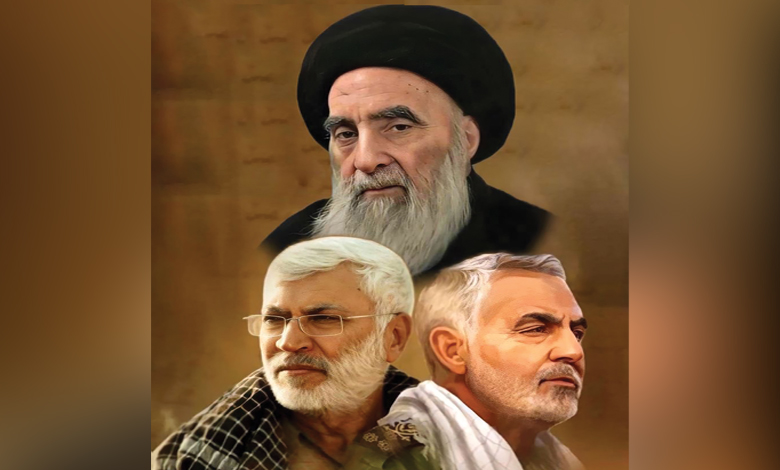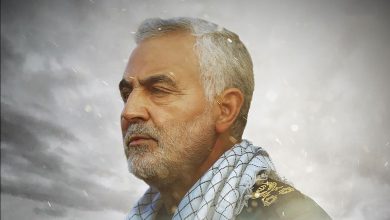Part Four: Soleimani and Religious Authority – A Special Bond with Najaf, Qom, and Tehran (Section One)

 Political Section
Political Section
Qassem Soleimani’s Relations with the Shia Marja’iyya
Qassem Soleimani’s relationship with the Shia religious authority was not merely ceremonial or respectful; rather, it embodied an organic, ideological, and strategic bond that influenced multiple dimensions of his intellectual, political, and field activities. From the beginning, Soleimani grew not merely as a military commander but as a child of the Ahl al-Bayt school of thought, a tradition in which the religious authority in Qom, Najaf, and, to some extent, Tehran, formed its intellectual and spiritual backbone.
In Soleimani’s perspective, the Shia Marja’iyya was not just a jurisprudential institution but a moral and strategic force capable of saving a nation from collapse and guiding the Ummah in the path of resistance against oppression. Therefore, his relationships with the maraji’ were never limited to formal meetings or political reporting but were founded on heartfelt faith and mutual trust. In Qom, his close ties with Ayatollah Mesbah Yazdi and Ayatollah Javadi Amoli are well documented. He frequently attended private sessions with these two prominent scholars and followed their guidance not only with respect but with practical commitment. Ayatollah Mesbah referred to him as a “child of the Wilayat school” and considered Soleimani a prominent example of a “righteous servant” in the realm of politics and jihad.
Historically, Soleimani’s main connection to the marja’iyya traces back to Najaf. He became familiar with the Najaf religious environment during the Iran-Iraq War and deepened his ties with the seminary there after Saddam’s fall. Numerous accounts report private meetings between Soleimani and Grand Ayatollah Sistani in Najaf. What distinguished this relationship was not merely the meetings themselves but an internal understanding regarding the historical responsibility of the Shia in regional developments.
Despite his usual caution, Ayatollah Sistani demonstrated during critical moments—including the issuance of the fatwa of Jihad Kifai against ISIS—his trust in Soleimani’s honesty, prudence, and commitment. Soleimani, in response, never bypassed the marja’iyya’s fatwas but regarded them as the starting point for a new phase of resistance and mobilization in Iraq.
Tehran also held a special position. The Supreme Leader, Ayatollah Ali Khamenei, was not only a religious authority but also the guardian of the nation. Soleimani’s relationship with him was not simply a disciple-mentor connection but a form of devoted obedience and profound understanding of the concept of Wilayat al-Faqih. He frequently emphasized in private gatherings and letters that “my honor is to be a soldier of the Wilayah.” This allegiance was based on spiritual insight and faith rather than bureaucratic military hierarchy, reflecting a prioritization of the Islamic Ummah’s interests over military or regional analysis.
Soleimani’s connection to the marja’iyya also encompassed defending them against foreign threats and internal seditions. During ISIS’s occupation of parts of Iraq, one of the group’s covert goals was to weaken the Shia marja’iyya and undermine the religious base of the seminaries. Soleimani recognized this and not only defended the sacred sites of Karbala and Najaf but also organized the Popular Mobilization Forces (PMF) to protect the marja’iyya and its legitimacy. His presence on the battlefield alongside clerics in jihad attire demonstrated a deep connection between jurisprudence and sacrifice, between seminary and front line.
It is noteworthy that Soleimani never replaced the marja’iyya in any of his field activities. He always regarded them as superior, consulting Grand Ayatollah Sistani and other Qom scholars on political and strategic steps. For instance, in sensitive issues in Syria and Lebanon, he frequently shared his analyses with Sistani and the Qom scholars, demonstrating that he was not only a professional commander but also a political thinker with a seminary-based identity.
Before his deployment to Syria and during his presence in Iraq, Soleimani maintained special, regular communications with Grand Ayatollah Sistani, holding private and substantive meetings. He also had close and cordial relationships with other Najaf maraji’, particularly the late Grand Ayatollah Sayyid Muhammad Saeed Hakim, based on mutual respect and friendship.
Additionally, Soleimani maintained respectful and purposeful interactions with Grand Ayatollah Ishaq Fayyad and Grand Ayatollah Bashir Najafi, reflecting his deep understanding of the marja’iyya’s role in Iraq’s affairs.
Importantly, Soleimani never disregarded the views of the Grand Marja’ in Iraq. He consistently followed the guidance and fatwas of Ayatollah Sistani in all major matters. This approach was not only out of personal respect but was also part of a religious and Wilayat mission assigned by the Supreme Leader, Ayatollah Ali Khamenei, who explicitly instructed Soleimani to act based on Sistani’s fatwas in all Iraqi matters. This adherence to the marja’iyya’s guidance was a key factor in Soleimani’s success in managing Iraq’s complex scene and strengthening the legitimacy of the resistance in the country.







